MEAT
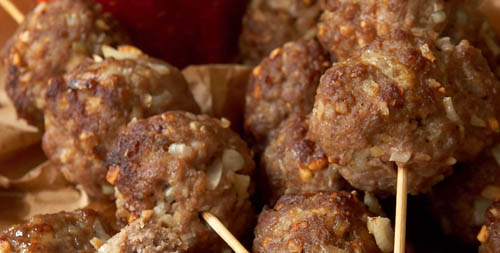
MOUSSAKA
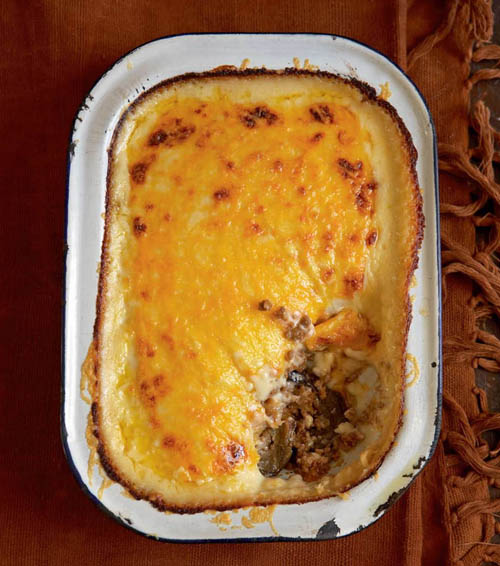
Contrary to popular belief, moussaka isn’t a purely Greek dish. It appears that the word itself is of Persian-Arabic origin, i.e. magouma which in Arabic means ‘soaked’ and in Persian means ‘a dish of many layers’ including minced lamb, brinjal and onion. There are endless variations across the Middle East and it is from there, via the Mediterranean, that it found its way to Africa.
- 1 kg brinjals, sliced
- salt and pepper
- 4 Tbsp olive oil
- 2 onions, finely chopped
- 2 cloves garlic, crushed
- 500 g minced beef
- 1 × 410 g can peeled tomatoes
- ½ tsp ground cloves
- 1 tsp ground cinnamon
- grated cheddar cheese for sprinkling
- CHEESE SAUCE
- 60 g butter
- 60 g cake flour
- 600 ml milk
- 100 g cheddar cheese, grated
- salt and pepper
- Preheat the oven to 200 °C. Grease a large ovenproof dish.
- Place the brinjal slices in a colander and sprinkle them with the salt. Set aside to drain for 1 hour, then rinse thoroughly in cold water and pat dry. Sprinkle the slices with a little of the olive oil and fry in a frying pan for 1 minute on each side, then set aside.
- Heat the remaining oil in a pot and fry the onions for 5 minutes over a low heat, add the garlic and beef mince and fry until light brown. Finally, add the tomatoes, cloves, cinnamon and season with salt and pepper. Cook for 5 minutes.
- For the sauce, melt the butter in a saucepan and stir in the flour.
- Add the milk and keep stirring until the sauce is smooth. Add the cheese and stir until it has completely melted, then season with salt and pepper.
- Arrange a layer of brinjal in the prepared dish, followed by a layer of mince. Repeat. Pour over the cheese sauce and sprinkle with the grated cheese. Bake for 45 minutes.
- Serve with Three-Bean Salad with Olives (see page 139). SERVES 4–6
LAMB AND BRINJAL STEW
This highly popular North African dish creates its own, delicious gravy. Lamb neck is a good cut to use as it is ideal for the low heat and lengthy cooking time required.
- 4 Tbsp vegetable oil
- 500 g stewing lamb (e.g. neck)
- 3 onions, chopped
- 2 cloves garlic, crushed
- 2 × 410 g cans peeled tomatoes
- 1 Tbsp tomato paste
- 1 tsp dried thyme
- 1 litre chicken stock
- 1 large brinjal, cubed
- salt and pepper
- Heat the oil in a large saucepan and brown the lamb in batches.
- Remove from the pan and set aside.
- In the same pan, sauté the onions until soft, and add the garlic, tomatoes, tomato paste and thyme. Cook, uncovered, for 5 minutes then pour in the chicken stock and add the lamb.
- Simmer for 50–60 minutes. Stir in the brinjal cubes and simmer for a further 10 minutes, or until cooked. Season to taste.
- Serve with Savoury Rice (see page 133). SERVES 4–6
LAMB SHANKS WITH BABY ONIONS, BRINJALS AND PEPPERS
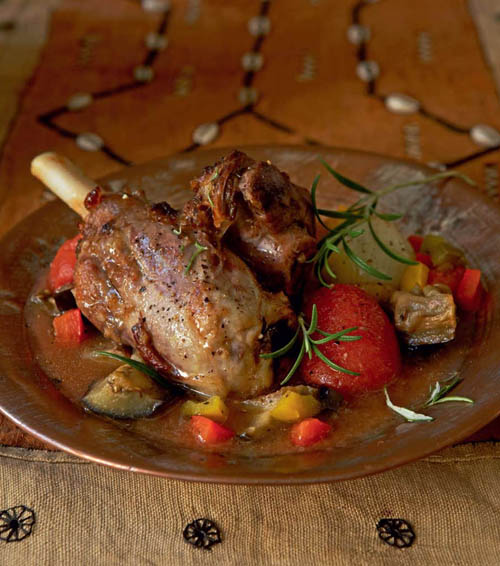
This is a really flavourful lamb dish of West African origin and the perfect meal for a winter evening. Be sure to cook lamb shanks slowly.
- 6 lamb shanks
- 1 cup seasoned cake flour (i.e. with salt and pepper)
- ¼ cup olive oil
- 1 red pepper, diced
- 1 yellow pepper, diced
- 1 green pepper, diced
- 36 whole baby onions
- 1 × 410 g can peeled tomatoes
- 1 brinjal, cubed
- 1 cup white wine
- 2 cups chicken stock
- salt and pepper
- Preheat the oven 175 °C.
- Dust the lamb shanks with the seasoned flour and fry in the olive oil until brown.
- Transfer the shanks to an ovenproof dish. Arrange all the vegetables over the shanks. Combine the wine and chicken stock and pour over the shanks and vegetables. Season to taste. Cover the dish and roast for 1–1¼ hours.
- Serve with rice. SERVES 4–6
LAMB SAUSAGES WRAPPED WITH BACON
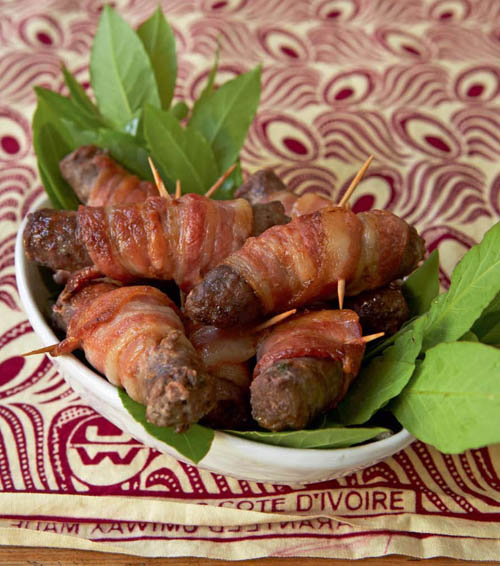
If you’d like to serve these as snacks instead of a main course, use cocktail sausages wrapped with half a bacon rasher each.
- 12 rashers streaky bacon
- 12 lamb or beef sausages
- Wrap a bacon rasher around each sausage and fasten with a toothpick. Place under the grill of an oven (or over hot coals), turning regularly until they are brown. Serve with Sweet Potato and Butternut Mash (see page 150). SERVES 4–6
LAMB KIDNEYS
It is traditional in Africa to soak raw kidneys in cold water for 30 minutes before cooking, to remove their distinctive odour. This dish is perfect for breakfast or brunch.
- 2 Tbsp vegetable oil
- 1 onion, roughly chopped
- 2 cloves garlic, peeled
- 1 fresh green chilli, finely chopped
- 12 lamb kidneys, thin layer and white membrane removed
- 100 ml white wine
- 100 ml chicken stock
- 1 Tbsp cream cheese
- salt and pepper
- Heat the oil in a frying pan and sauté the onion until soft. Add the garlic and chilli and stir-fry for 2 minutes, then add the kidneys and cook for 3 minutes. Pour in the wine and when it starts to boil, add the chicken stock and cream cheese. Season with salt and pepper. Serve with mashed potatoes. SERVES 4–6
MOROCCAN LAMB TAGINE
Tagine dishes are really slow-cooked stews, usually made with mutton, or lamb, which is even more tender and therefore cuts down on cooking time. This is a well-known Moroccan recipe; the stew is braised at a low temperature to ensure extra tender meat while the aromatic vegetables are characterised by a spicy sauce. Tunisian cuisine also offers tagines, but those are more akin to Italian frittatas.
- 12 lamb chops
- salt and pepper
- 4 Tbsp olive oil
- 2 onions, chopped
- 3 carrots, peeled and thickly sliced
- 3 cloves garlic, crushed
- 2 tsp turmeric
- ¼ tsp ground cinnamon
- ¼ tsp ground ginger
- 4 tsp chopped coriander leaves
- 2 cups beef stock
- 12 pitted prunes
- ¼ cup pine nuts, toasted
- Season the chops with the salt and pepper. Heat the oil in a tagine or casserole dish and brown the chops on both sides on the stove top. Add the onions, carrots and garlic, and sauté for 3 minutes.
- Add the turmeric, cinnamon, ginger and coriander leaves and stir to combine. Pour in the stock and adjust the seasoning.
- Simmer for 1 hour, but add the prunes 10 minutes before the end of cooking time.
- Transfer to a serving dish and sprinkle the pine nuts on top.
- Serve with rice or couscous. SERVES 4–6
ROAST LEG OF LAMB WITH BRINJALS
Salting the cubed brinjals and leaving them to ‘weep’ for a few minutes before cooking eliminates their naturally bitter taste, but rinse them well afterwards so that most of the salt is removed. Harissa paste is a hot red chilli paste.
- 2 kg leg of lamb
- salt and pepper
- ¼ cup olive oil
- 4 red onions, cut into wedges
- 6 cloves garlic, chopped
- 1 × 410 g can peeled tomatoes
- 1 cup beef stock
- 1 Tbsp Harissa Hot Chilli Paste (see page 153)
- 1 tsp dried thyme
- ½ tsp chopped fresh mint
- 3 brinjals, cubed
- Preheat the oven to 160 °C.
- Put the meat into a deep roasting pan and season with the salt and pepper.
- In a bowl, mix together the olive oil, onions, garlic, tomatoes, beef stock, harissa paste, thyme, mint and salt and pepper. Pour the mixture over the meat. Cover securely with foil and roast for 45 minutes. Add the brinjals, cover again and roast for a further 45 minutes.
- Baste the meat with the pan juices and roast, uncovered, for another 15 minutes, by which time the meat should be tender.
- Serve with Garlic Potatoes (see page 153) and bread to soak up the sauce. SERVES 4–6
SPICED LAMB CHOPS
It is traditional for many Africans to display their wealth by the quantity of livestock they own. When a man plans to marry he has to work hard to purchase sufficient livestock to be slaughtered during the wedding ceremony. Lamb is often used for this purpose and the meat is prepared in a variety of ways.
- 3 Tbsp olive oil
- 1 onion, chopped
- 3 cloves garlic, crushed
- 1 tsp soy sauce
- 1 fresh green chilli, chopped
- ¼ cup red wine vinegar
- 2 Tbsp balsamic vinegar
- ½ cup red wine
- 2 cups beef stock (from 1 stock cube)
- salt and pepper
- 12 lamb chops
- Heat the oil in a frying pan, then sauté the onion for 5 minutes. Add the garlic, soy sauce, chilli, red wine vinegar and balsamic vinegar, then simmer, covered, for 3 minutes. Pour in the red wine and cook for an additional 3 minutes. Add the beef stock and cook for 10–15 minutes over a low heat. Season with the salt and pepper. Leave to cool.
- Marinate the chops in the sauce overnight.
- The following day, prepare a charcoal fire. Braai the chops over the coals for approximately 10 minutues, basting regularly with the leftover marinade.
- Serve the chops with roast potatoes and a salad of your choice. SERVES 4–6
LAMB CURRY
This is a simplified version of Zanzibar’s beef curry, which is called M’chuzi wanyama.
- 6 Tbsp olive oil
- 1 kg lamb, cubed
- 3 onions, chopped
- 4 cloves garlic, crushed
- 2 Tbsp medium curry powder
- 1 tsp turmeric
- ½ tsp garam masala
- ¼ tsp cayenne pepper
- 4 fresh tomatoes, peeled and chopped
- 1 chicken stock cube, dissolved in 3 cups boiling water
- salt and freshly ground pepper
- In a frying pan, heat 4 tablespoons of the oil and brown the meat in batches. Transfer the lamb to a stovetop casserole dish.
- Add the remaining oil to the same frying pan and sauté the onions and garlic until soft. Stir in the curry powder, turmeric, garam masala and cayenne pepper and fry for 5 minutes. Add the tomatoes and cook until soft, then pour in the chicken stock and boil for 3 minutes. Remove from the heat. Once cool, blend until smooth and pour over the lamb. Cover the dish and leave to simmer gently until the meat is tender – about 1 hour.
- Serve with basmati rice. SERVES 4–6
MUTTON WITH SWEETCORN AND BEANS
Meat, maize and beans represent the staple diet in many African countries. This is a traditional recipe combining all three.
- 3 Tbsp vegetable oil
- 500 g mutton, cubed
- 2 large onions, chopped
- 2 cloves garlic, crushed
- 1 tsp dried thyme
- 1 tsp turmeric
- 1 tsp dried rosemary
- 1 tsp cayenne pepper
- 1 Tbsp tomato paste
- 4 cups chicken stock
- 1 cup cooked sweetcorn or canned sweetcorn
- 1 × 410 g can red or white beans, drained
- salt and pepper
- Heat the oil in a large frying pan and lightly brown the mutton.
- Add the onions and garlic and fry until soft, then stir in the thyme, turmeric, rosemary, cayenne pepper and tomato paste. Fry together for 3 minutes then pour in the stock. Simmer gently for 1 hour. Add the sweetcorn and beans and simmer for a further 10 minutes.
- Serve with rice. SERVES 4–6
BEEF AND VEGETABLE PIE
- 4 Tbsp vegetable oil
- 500 g stewing steak, cubed
- 1 large onion, chopped
- 1 stick celery
- ¼ cup red wine
- 2 cups beef stock
- 2 carrots, peeled and sliced
- 250 g button mushrooms, sliced
- ½ cup each shelled peas and fresh cream
- 2 Tbsp cake flour
- salt and pepper
- 1 egg yolk, beaten
- PASTRY
- 250 g cake flour
- ½ tsp salt
- 150 g butter, cut into pieces
- 180 ml cold water
- 1 tsp lemon juice
- 1 egg yolk
- In a large pot, heat the oil and brown the meat. Add the onion and celery and sauté until soft. Pour in the wine and beef stock and simmer for 1 hour. Stir in the carrots, mushrooms and peas. Mix the cream into the flour, add to the meat and season to taste.
- Simmer for 10 minutes until the sauce thickens. Leave to cool.
- Grease a pie dish and preheat the oven to 180 °C. For the pastry, sift the flour and salt into a bowl and rub in the butter until the mixture resembles fine breadcrumbs. Beat together the water, lemon juice and egg yolk then mix with the flour until a dough forms. Roll out half of the pastry and line the pie dish.
- Spoon the cooled filling into the pie dish and cover with the rest of the pastry. Brush with the beaten egg yolk and bake for 30 minutes.
- SERVES 4–6
BOBOTIE
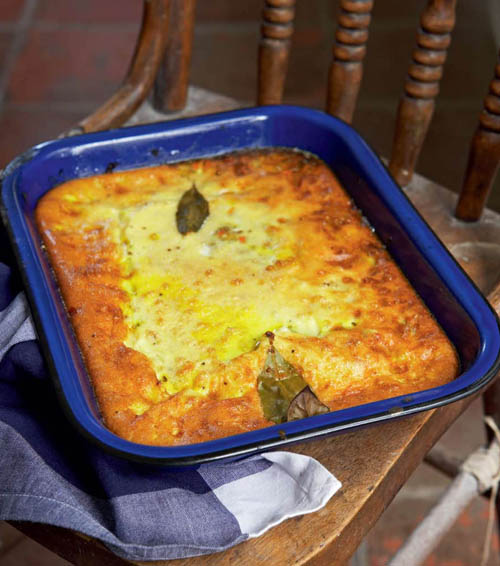
This is a traditional South African dish made with minced beef or lamb. However, minced chicken may also be used as a healthy and delicious alternative. Of Cape malay origin, bobotie has a spicy, fruity taste with just a hint of curry.
- 3 Tbsp butter
- 2 onions, finely chopped
- 1 stick celery, finely chopped
- 3 cloves garlic, crushed
- 500 g minced beef
- 1 carrot, peeled and finely chopped
- ¼ cup raisins
- 1 Tbsp mild curry powder
- 1 tsp turmeric
- ½ tsp ground cinnamon
- ¼ tsp ground cloves
- 1 large pinch cayenne pepper
- ½ tsp sugar, dissolved in 2 Tbsp white vinegar
- salt and pepper
- TOPPING
- 1 cup double cream
- 2 eggs
- salt and pepper
- Preheat the oven to 160 °C. Grease a deep, ovenproof dish.
- In a pot, heat the butter and sauté the onions and celery until soft. Add the garlic and beef, and stir-fry with a fork to separate the mince. Add the rest of the ingredients (except the salt and pepper) and fry until well combined, then season with the salt and pepper. Spoon the mixture into the ovenproof dish and press gently, levelling the top with the back of a spoon.
- Beat together all the topping ingredients lightly with a fork, then pour over the bobotie. Bake for 30 minutes.
- Serve with rice. SERVES 4–6
BEEF POT ROAST
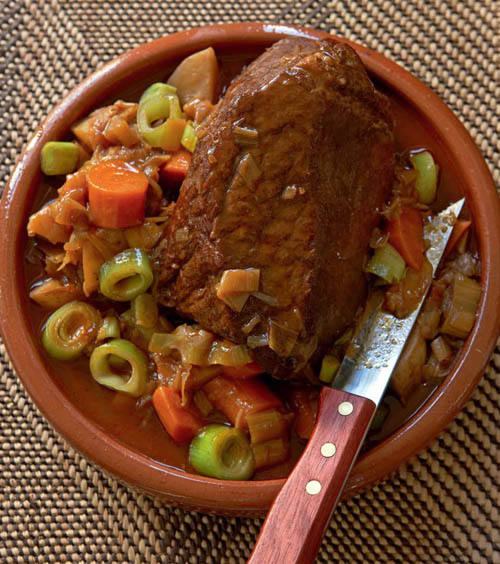
Traditionally, African people had no access to modern ovens (and many still don’t), so pot-roasting is an effective alternative method for roasting meat.
- 1 Tbsp olive oil
- 125 g butter
- 2 kg topside beef roast
- 4 medium carrots, peeled and chopped
- 2 large potatoes, chopped
- 1 large onion, sliced
- 3 medium leeks, chopped
- ¼ cup cake flour
- ½ cup dry red wine
- 1 litre beef stock
- ¼ cup tomato paste
- ¼ cup worcestershire sauce
- In a large pan, heat the oil and 20 g of the butter, add the beef and brown all over. Set the meat aside in a large pot.
- In the same pan, heat another 20 g of the butter and then add the carrots, potatoes, onion and leeks and cook until browned and softening. Set the vegetables aside.
- In the same pan, heat the remaining butter, add the flour and stir until light brown. Remove the pan from the heat and gradually stir in the wine and stock. Return the pan to the heat and continue stirring until the sauce thickens.
- Add the sauce and any remaining juices to the pot with the meat, add the tomato paste and Worcestershire sauce and simmer, covered, for about 2 hours or until the beef is tender, turning it occasionally. Add the vegetables that were set aside for the final 20 minutes of cooking, to simmer with the beef.
- Serve with Special Cornmeal Bread (see page 166), which is delicious with the gravy, and Green Bean and tomato Salad (see page 134). SERVES 4–6
BEEF STEW AND PAP
This is a favourite African stew which is sure to impress most people. It is easy to cook, whether at home or at a bus terminal! Generally stewing or goulash steak is used, but for a tastier and more tender cut, rump may be substituted and the cooking time be reduced accordingly.
- ¼ cup olive oil
- 1 onion, roughly chopped
- 1 kg beef stewing steak or goulash
- ½ cup red wine
- 2 cups beef stock
- 1 Tbsp tomato paste
- 5 carrots, peeled and sliced 2 cm thick
- 8 baby onions, peeled and diced
- 2 potatoes, peeled and cubed
- salt and pepper
- mealiepap to serve
- Heat the oil in a large pot and sauté the onion until soft. Add the beef and brown lightly. Pour in the wine, beef stock and tomato paste. Stir gently until the paste has dissolved, then simmer over a low heat for 40 minutes.
- Add the carrots and baby onions and simmer for 15 minutes.
- Add the potatoes and simmer for another 7 minutes, or until the potatoes are cooked but still firm. Season to taste with the salt and pepper.
- Serve with the mealiepap. SERVES 4–6
SPICED BEEF FILLET
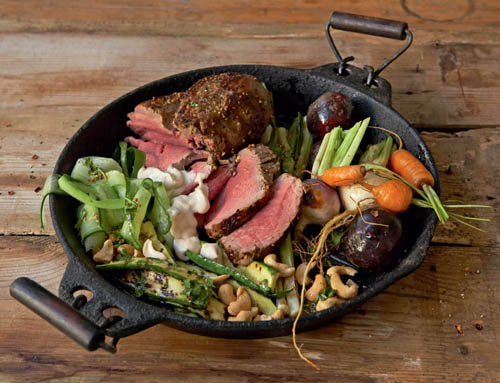
In ancient Egypt this dish was reserved for the pharaohs. Luckily we can all enjoy it today. Tahini is a paste of hulled, lightly roasted sesame seeds, popular in Middle Eastern cooking.
- 1 Tbsp black peppercorns, crushed
- 1 Tbsp mustard seeds
- 1 Tbsp coriander seeds, crushed
- 500 g beef fillet
- 3 Tbsp butter
- SAUCE
- ¼ cup tahini
- 1 cup plain yoghurt
- juice of 1 lemon
- 2 Tbsp chopped fresh coriander
- ¼ tsp cayenne pepper
- Preheat the oven to 200 °C.
- Mix together the peppercorns, mustard and coriander seeds, then coat the fillet with the mixture.
- Heat the butter in a frying pan, sear the meat on all sides, then transfer to a roasting pan and roast for 15 minutes. Leave the meat to rest for 10 minutes before slicing.
- In the meanwhile, make the sauce. Gently mix all the ingredients until smooth, then transfer the sauce to a bowl.
- Slice the meat thinly and arrange on a platter. Serve with the sauce, roasted vegetables, baked jacket potatoes and Cucumber and Baby Marrow Salad (see page 135). SERVES 4–6
OXTAIL STEW WITH MEALIEPAP
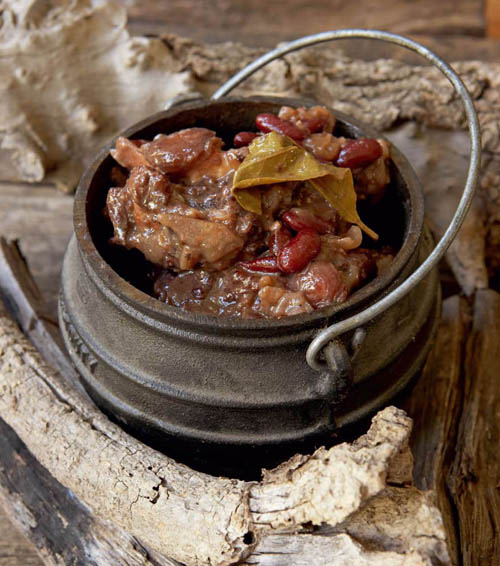
Mealiepap gives this tasty dish it’s truly African flavour. No self-respecting African oxtail stew is served without it!
- 1 kg oxtail, cut into joints
- cake flour for dusting
- 5 Tbsp vegetable oil
- 5 onions, roughly chopped
- 1 clove garlic, crushed
- 2 cups beef stock
- 2 cups red wine
- 2 bay leaves
- 3 black peppercorns
- 1 × 410 g can red beans or dried red beans, cooked
- salt and pepper
- Dust the oxtail with the flour and heat the oil in a pan. Fry the meat on both sides until brown, then transfer to a large pot.
- Fry the onions and garlic in the same pan for 5 minutes, then add the mixture to the oxtail. Pour the beef stock and wine over the oxtail, add the bay leaves and peppercorns, and simmer gently, covered, for 3 hours.
- Add the beans to the pot, season with the salt and pepper, and leave to simmer for another 10 minutes.
- Serve with Mealiepap with Onion and Tomato Sauce (see page 141). SERVES 4–6
OX LIVER, ONIONS AND MUSHROOMS
Lamb livers may be substituted for ox livers.
- 700 g ox liver, sliced into 6
- salt and pepper
- 2 Tbsp butter
- 3 Tbsp vegetable oil
- 3 onions, thinly sliced
- 2 cups sliced button mushrooms
- ¼ cup white wine
- ¼ cup sherry
- ¼ cup fresh cream
- 1 tsp dried thyme
- 2 tsp butter
- Pat the liver slices dry and season them with the salt and pepper. In a frying pan, heat the butter and 2 tablespoons of the oil and fry the liver quickly on both sides, in batches depending on the size of the frying pan. Keep warm.
- In another frying pan, fry the onions in the remaining tablespoon of oil until brown. Add the mushrooms and then stir-fry for 2–5 minutes. Season with salt and pepper, then pile the mushrooms on top of the slices of liver.
- Pour the wine and sherry in the frying pan in which the mushrooms were fried and bring to the boil, then stir in the cream and thyme and beat in the 2 teaspoons of butter. Season to taste with salt and pepper.
- Arrange the livers and mushrooms in a serving dish and pour over the sauce.
- Serve with mashed potatoes. SERVES 4–6
TONGUE WITH CHICKPEA AND MUSTARD SAUCE
Tongue may not be everyone’s favourite, but if cooked correctly can be extremely tasty and tender. It is popular throughout Africa because it is one of the cheapest cuts of meat.
- 1 ox tongue
- 2 whole onions, peeled
- 2 sticks celery, halved
- 1 carrot
- 1 leek
- 8 cups water
- SAUCE
- 100 g butter
- 4 Tbsp Dijon mustard
- ¾ cup chicken stock
- 3 Tbsp white wine
- 1 tsp cornflour
- 1 × 410 g can chickpeas, drained
- salt
- In a pot, simmer the tongue together with the rest of the ingredients for 2 hours until tender, but not overcooked.
- In the meanwhile, make the sauce. Melt the butter in a saucepan and stir in the mustard, chicken stock, wine and cornflour. Simmer for 5 minutes. Add the chickpeas and simmer for another 5 minutes, then season with the salt.
- Remove the skin from the tongue before slicing it. Arrange the slices in a serving dish and pour the sauce over the tongue.
- Serve with Three-Bean Salad with Olives (see page 139). SERVES 4–6
SUYA

Very popular in West Africa, suya originated with the Hausa people in Northern Nigeria and Niger. It is a form of shish kebab and has proved to be a favourite evening snack sold by many roadside vendors and restaurants. The kebabs can be grilled in the oven or over coals on a charcoal braai. Bamboo skewers burn easily, so wrap both ends in foil or soak them in water for 30 minutes before using.
- 1 kg minced beef
- ½ cup roasted peanuts, finely chopped
- ¼ tsp chilli powder
- 1 onion, grated
- 1 tsp ground ginger
- 1 cup fresh breadcrumbs
- salt and pepper
- 6 bamboo skewers
- olive oil
- Preheat the grill.
- In a bowl, combine the beef and the other ingredients and shape into approximately 24 meatballs. Thread the meatballs onto the bamboo skewers.
- Grill for about 10 minutes, then brush with the olive oil.
- Serve with Harissa Hot Chilli Paste (see page 153). serves 4–6
J’S STEAK
It took me a while to perfect the sauce for this recipe, but as everyone enjoys it, it was worth the effort!
- 6 beef steaks
- SAUCE
- 3 Tbsp butter
- 2 onions, roughly chopped
- 3 cloves garlic, crushed
- 3 tomatoes, peeled and chopped
- ½ cup beef stock
- ½ cup tomato sauce
- ½ cup J’s Spiced Fruit Chutney (see page 154)
- 2 Tbsp sugar
- 6 Tbsp red wine vinegar
- 1 fresh green chilli, finely chopped
- 3 Tbsp Worcestershire sauce
- Heat the butter in a pan. Sauté the onions for 5 minutes. Add the rest of the sauce ingredients and simmer for 5 minutes.
- Keep warm.
- Grill the steaks (4 minutes for rare, 5 minutes for medium and 6 minutes for well done), then spoon the sauce over them.
- Serve with Sweet Potato and Butternut Mash (see page 150), Malawi’s Favourite Cabbage Salad (see page 135) and J’s Spiced Fruit Chutney (see page 154). SERVES 4–6
CURRIED RUMP STEAK WITH CHILLI ONION RINGS
Indian settlers, particularly in East Africa and South Africa, introduced the use of curries and spices into African cooking.
- 5 rump steaks
- 3 Tbsp butter
- MARINADE
- 2 Tbsp medium curry powder
- 4 Tbsp olive or vegetable oil
- 2 Tbsp grated fresh ginger
- 4 Tbsp soy sauce
- ONION RINGS
- 300 g cake flour (plus extra for dusting)
- 2 tsp chilli powder
- ½ tsp salt
- 2 tsp ground cumin
- 1 fresh green chilli, deseeded and finely chopped
- ¼–½ cup water
- 3 onions, sliced ino 2 mm-thick rings
- ± 4 cups vegetable oil for deep-frying
- Mix together all the marinade ingredients and marinate the steaks for 1 hour. In the meanwhile, for the onion rings mix together the flour, chilli powder, salt, cumin, green chilli and water to make a batter with a thick, dropping consistency. Dust the onion rings with flour and dip them into the batter. In a deep frying pan, heat the vegetable oil and then fry the onion rings until golden brown.
- Remove the steaks from the marinade, pat them dry and reserve the marinade. Heat the butter in a frying pan and brown the steaks on both sides, about 4 minutes per side. Heat the marinade in a saucepan for 1 minute and pour into a serving dish. Add the steaks to the dish and arrange the onion rings on top.
- Serve with Sweet Potato Chips (see page 150). SERVES 4–6
PAP AND BOEREWORS WITH TOMATO AND ONION SAUCE
This is one of South Africa’s favourite dishes and is usually enjoyed at weekend braais. Although the wors (or farmer’s sausage) is grilled on the braai, it can be pan-fried if you prefer. Pap’is the shortened form of mealiepap (maize meal). This is a simple yet tasty dish.
- 6 cups water
- 3 cups mealie meal
- 1 tsp salt
- 1–2 kg boerewors
- TOMATO AND ONION SAUCE
- 4 Tbsp vegetable oil
- 3 onions, finely chopped
- 9 tomatoes, peeled and chopped
- 1 Tbsp tomato paste
- 1 beef stock cube
- ½ cup water
- salt and pepper
- To make the sauce, heat the oil in a pot and sauté the onions for 10 minutes, or until soft. Add the tomatoes and tomato paste and stir over medium heat until the tomatoes are very soft. Stir in the beef stock and water until the cube has dissolved totally, then simmer for 15 minutes. Season with the salt and pepper, but be careful as the beef stock is already very salty.
- For the mealiepap, bring the water to a boil in a large pot. Sprinkle in the maize meal, little by little, stirring continuously with a wooden spoon until thick. Reduce the heat, season with salt and cook, covered, for 15 minutes.
- In the meanwhile, grill the boerewors for approximately 10 minutes, or until done. Serve the boerewors with the pap and sauce. SERVES 4–6
BOEREWORS AND PINEAPPLE KEBABS WITH ONION MARMALADE
The contrasting yet complementary flavours in this dish create an unusual taste experience.
- 1 kg boerewors, cut into 2 cm-thick slices
- 2 large pineapples, peeled and cubed
- 2 onions, cut into wedges
- 6 bamboo skewers (see page 69)
- vegetable oil
- ONION MARMALADE
- 3 Tbsp vegetable oil
- 5 onions, sliced into rings
- 2 tsp brown sugar
- ¼ cup balsamic vinegar
- a pinch of cayenne pepper
- To make the onion marmalade, heat the oil in a frying pan. Add the onions and fry until light brown in colour. Add the sugar and balsamic vinegar, stirring until the onions are coated with the vinegar. Season with the cayenne pepper.
- Thread the boerewors slices, pineapple cubes and onion wedges onto the skewers, alternating onion, boerewors, pineapple, boerewors. Brush each kebab with the vegetable oil.
- Heat a griddle and cook the kebabs.
- Serve the kebabs with the onion marmalade and Sweet Potato and Butternut Mash (see page 150). SERVES 4–6
ROAST LOIN OF PORK IN LEMON CREAM SAUCE
Some African groups do not eat pork for religious reasons. However, in most countries, pork is generally a favourite dish as it is cheaper than beef or lamb. The piquant sauce in this dish adds an interesting touch to a standard roast.
- 50 ml olive oil
- 2 kg loin of pork
- 6 cloves garlic, crushed
- 2 Tbsp chopped fresh rosemary
- 2 cups fresh cream
- salt and pepper
- juice of 1 lemon
- Preheat the oven to180 °C.
- Heat the oil in a large frying pan and brown the pork. Transfer the meat to a roasting dish.
- Discard the fat from the frying pan, add the garlic and rosemary, and pour in the cream. Season with the salt and pepper. Remove the pan from the heat and quickly stir in the lemon juice. Pour the cream sauce over the meat in the roasting dish and roast, covered, for 60 minutes, and uncovered for a further 20 minutes. Leave the meat to stand for 10 minutes before carving.
- Serve with Roasted Rosemary Potatoes (see page 146). SERVES 4–6
NIGERIAN MEAT KEBABS
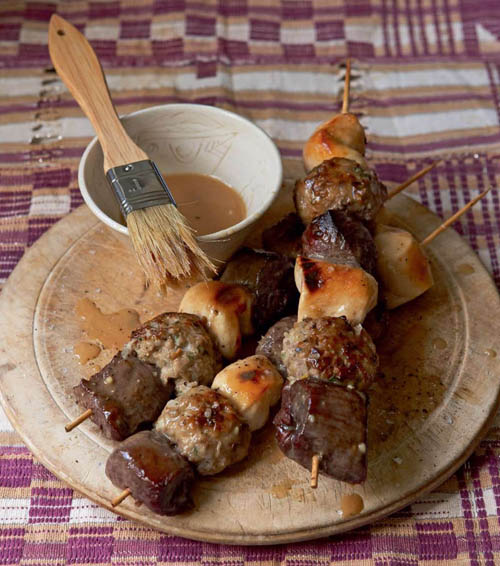
Many Nigerians believe that to create good flavour in food, it is essential to mix different kinds of meat. These kebabs are a good example of this and are a popular addition to the barbecue menu of Nigerian immigrants in other countries.
- 200 g minced beef
- 1 onion, finely chopped
- 1 Tbsp chopped fresh parsley
- ½ tsp salt
- 2 Tbsp fresh breadcrumbs
- 6 bamboo skewers (see page 69)
- 4 chicken breasts, cubed
- 4 ostrich steaks, cubed
- BASTING SAUCE
- ½ cup honey
- ½ cup brown or white vinegar
- 3 Tbsp Dijon mustard
- 4 cloves garlic, crushed
- In a large bowl, combine the mince, onion, parsley, salt and breadcrumbs and shape into approximately 12 small meatballs. Thread them onto the skewers, alternating with the chicken and ostrich cubes.
- Combine all the basting sauce ingredients. Braai the kebabs over the coals for 10 minutes, basting regularly with the sauce.
- Serve with Yam Patties (see page 21) and the basting sauce. SERVES 4–6
ROAST LOIN OF PORK WITH FENNEL BULBS

Dried fennel leaves, as well as the fleshy bulb and seeds, have an anise flavour. Toasting the seeds accentuates their flavour.
- 6-rib pork loin standing rib roast (± 2 kg), skin scored
- 1 heaped Tbsp green fennel seeds, finely ground
- 4 cloves garlic, crushed
- 2 tsp coarse salt
- 6 fennel bulbs, halved
- 6 potatoes, peeled
- 2 cups beef stock
- salt and pepper
- APPLE SAUCE
- 4 apples, peeled and sliced
- 1 tsp sugar
- ¼ cup water
- 2 Tbsp lemon juice
- STEAMED SPINACH
- 2 kg spinach
- 3 Tbsp olive oil
- salt and pepper
- Preheat the oven to 200 °C. Mix the fennel seeds, garlic and coarse salt, then rub into the pork skin. Roast the pork, skin-side up, in a roasting dish for 15 minutes. Reduce the heat to 180 °C. Add the fennel bulbs and potatoes to the dish and roast with the pork for 80 minutes, basting regularly with the stock. Season. Bring all the apple sauce ingredients to the boil in a pot. Cook for 5–10 minutes, then purée in a blender until smooth.
- Wash the spinach well. Do not dry, but place in salted boiling water for 2 minutes. Drain, add the olive oil and season to taste. Transfer the roast onto a serving platter and carve into chops.
- Serve with the steamed spinach and apple sauce. SERVES 4–6
GAMMON WITH HONEY AND MUSTARD GLAZE
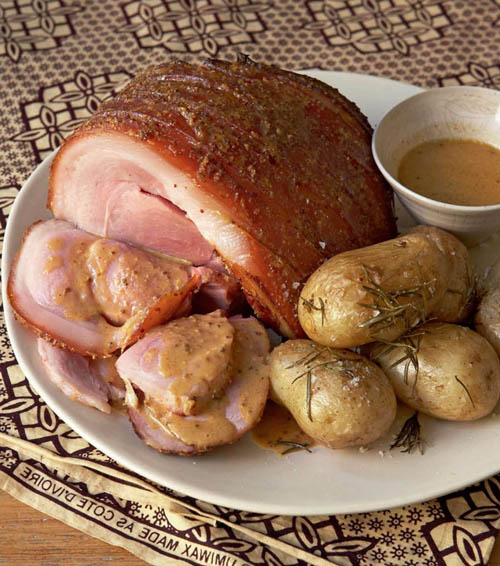
African cuisine has been influenced by Western Christmas traditions and so gammon is a popular addition to the festive table.
- 2 kg gammon
- 1 stick celery
- 2 whole onions, peeled
- 1 leek
- 2 carrots, peeled
- ½ cup chicken stock
- 2 Tbsp fresh cream
- HONEY AND MUSTARD GLAZE
- 100 ml honey
- 3 Tbsp wholegrain mustard
- 3 Tbsp hot English mustard
- 4 Tbsp white wine
- Preheat the oven to 200 °C.
- In a large pot, cover the gammon, celery, onions, leek and carrots with water and simmer for 40 minutes.
- In the meanwhile, mix together the glaze ingredients. Transfer the gammon to a roasting pan, score lines into the skin 1 cm apart and brush with the honey and mustard glaze.
- Roast for 30 minutes until the skin is shiny and keep basting with the glaze. Leave to rest for 10 minutes.
- Make a gravy by heating the pan juices. Add the half cup of chicken stock and bring to the boil. Stir in the cream and pour into a gravy boat.
- Serve with Roasted Rosemary Potatoes (see page 146). SERVES 4–6
PORK SPARERIBS
All over the world steakhouses vie to see who can produce the best pork spareribs and their success depends on the marinade in question. In Africa it is no different!
- 1.5–2 kg pork spareribs
- MARINADE
- 100 ml soy sauce
- 2 onions, finely chopped
- 1 clove garlic, crushed
- 1 Tbsp sherry
- 100 ml red wine vinegar
- ¾ cup beef stock
- salt
- 100 ml tomato sauce
- 1 tsp sugar
- 1 tsp ground ginger
- 1 tsp ground cloves
- 50 ml J’s Spiced Fruit Chutney (see page 154)
- Mix together all the marinade ingredients, then marinate the meat overnight.
- Remove the ribs from the marinade and grill, basting regularly with the marinade. The marinade can also be used as a sauce if it is simmered over a low heat for 5–10 minutes.
- Serve the ribs with Charmoula Potatoes (see page 149). SERVES 4–6
ROAST SADDLE OF SPRINGBOK WITH PRUNES AND PORT SAUCE
Springboks are antelopes, of which the largest number are found in the Kalahari. They are known for their running speed and jumping ability and as a result are the emblem for South Africa’s national rugby team.
- 3 Tbsp melted butter
- 3 Tbsp vegetable oil
- 2 tsp chopped mixed fresh herbs (e.g. parsley and rosemary)
- sea salt and crushed black peppercorns
- 3 kg saddle of springbok
- SAUCE
- 2 Tbsp butter
- 2 Tbsp cake flour
- 150 ml port or medium sherry
- 400 ml chicken stock
- 100 g soft dried prunes, pitted
- Preheat the oven to 180 °C.
- Mix together the butter, oil, herbs and salt and pepper, then rub over the meat. Roast in the oven for 30 minutes.
- In the meanwhile, make the sauce. In a saucepan, melt the butter and stir in the flour. Keep stirring until light brown then pour in the port or sherry. Gradually add the chicken stock and keep stirring until there are no lumps. Add the prunes and cook for 15 minutes.
- Slice the meat and serve with the sauce, Roasted Rosemary Potatoes (see page 146) and Green Bean and Tomato Salad (see page 134). SERVES 4–6
ROAST SADDLE OF SPRINGBOK WITH J’S SPICED FRUIT CHUTNEY
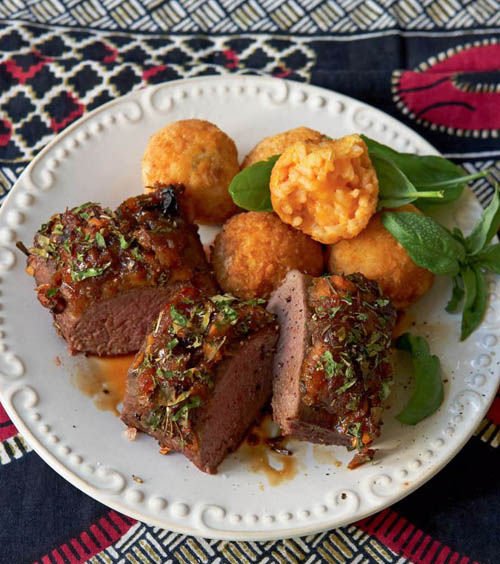
- 3 kg saddle of springbok
- salt and pepper
- butter
- 1 cup J’s Spiced Fruit Chutney (see page 154)
- 2 tsp chopped fresh herbs (e.g. parsley, rosemary, basil)
- 1 cup water
- Preheat the oven to 180 °C.
- Season the meat with salt and pepper to taste. Heat a large frying pan and add a knob of butter. Brown the meat all over. Transfer the meat to a roasting pan and spread the chutney over, then sprinkle the herbs on top. Roast in the oven for 30 minutes.
- Remove the meat and keep warm.
- To make a gravy, pour the water into the roasting pan and bring to the boil. Strain and decant into a gravy boat.
- Slice the meat and serve with the gravy and Rice Balls Stuffed with Cheese and Basil (see page 110). SERVES 4–6
VENISON KEBABS IN PORT AND ROSEMARY MARINADE
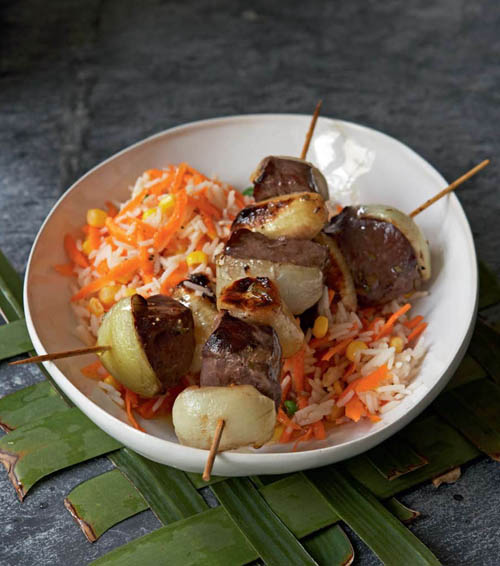
Originally the meat of any animal killed in hunting was called venison. Nowadays, the term refers to the meat of various species of deer.
- 2 onions, cut into wedges
- 700 g venison fillet, cubed
- 4 unripe bananas, peeled and sliced 2-cm thick
- 6 bamboo skewers (see page 69)
- MARINADE
- 1 onion, finely chopped
- 2 cloves garlic, crushed
- ½ tsp crushed black peppercorns
- 1 Tbsp chopped fresh rosemary
- 1 cup port
- 2 Tbsp vegetable oil
- 3 Tbsp white vinegar
- ½ cup beef stock
- 2 Tbsp water
- Thread the onion wedges, venison cubes and banana slices alternately onto each skewer. Place the skewers into a dish. Boil together all the marinade ingredients for 5 minutes then leave to cool. Pour over the kebabs and marinate for 1 hour.
- Grill the kebabs over coals or in a cast-iron griddle pan until cooked to taste, regularly basting with the leftover marinade.
- Serve with Rice and Sweetcorn Salad (see page 139). SERVES 4–6
VENISON AND BACON CASSEROLE
Because venison is low in fat, it is considered to be one of the healthier meats to eat. What fat there is, isn’t marbled as it is in beef or pork. Marbling, or animal fat, is the source of cholesterol.
- 1 kg venison, boned and cut into 1-cm cubes
- 3 Tbsp olive oil
- 150 g streaky bacon, diced
- 2 onions, finely chopped
- 2 carrots, peeled and sliced
- ½ cup red wine
- 2 cups chicken stock
- 3 bay leaves
- salt and pepper
- cake flour for dusting
- 200 g whole button mushrooms
- MARINADE
- ¼ cup olive oil
- ¼ cup brown vinegar
- ½ cup red wine
- 1 onion, cut into wedges
- ½ tsp dried rosemary
- Put the venison in a large bowl. Mix together all the marinade ingredients and pour over the meat. Marinate overnight. Discard the marinade and pat the meat dry.
- Heat 1 tablespoon of the oil in a frying pan and fry the bacon until brown. Add the onions and carrots and cook for 5 minutes. Pour in the wine and boil for 2 minutes. Add the chicken stock and bay leaves. Transfer all to a casserole dish.
- Season the meat with the salt and pepper and dust with flour. Add the remaining oil to the frying pan and fry the meat in batches, then add to the casserole dish and simmer for 40 minutes. Add the mushrooms and simmer for a further 30 minutes.
- Serve with rice and bread to mop up the sauce. SERVES 4–6














